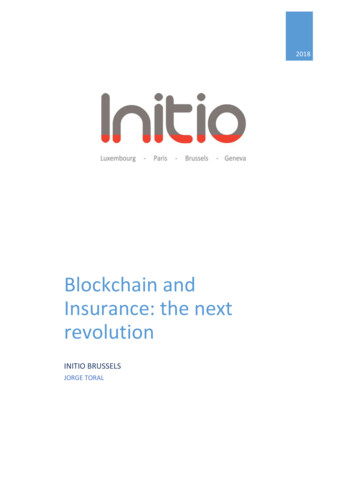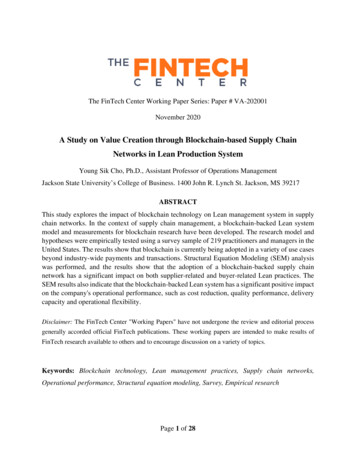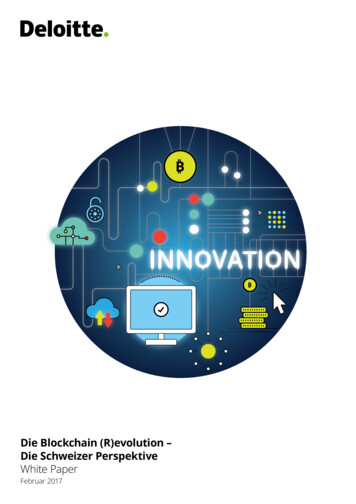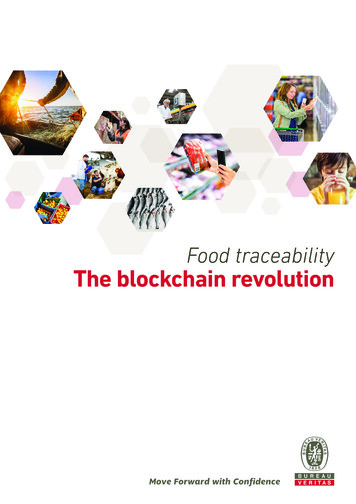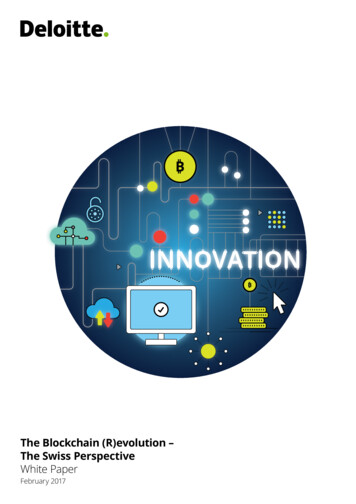
Transcription
The Blockchain (R)evolution –The Swiss PerspectiveWhite PaperFebruary 2017
Proposal title goes here Section title goes here 03
The Blockchain (R)evolution – The Swiss PerspectiveContentsSummary1. What is Blockchain?1.1 Technology on trend1.2 The value of trust1.3 Sample applications1.3.1 Bitcoin1.3.2 Smart contracts2. Blockchain and the path to innovation2.1 The technology-driven business innovation model2.1.1 Early development phase2.1.2 Standardisation phase2.1.3 Value creation phase2.2 Impact on key sectors of the Swiss economy3. Switzerland’s positioning3.1 Identification of business opportunities3.2 Supportive legal environment3.3 Controlled business process costs3.4 Coordinated standardisation3.5 Security and encryption3.6 Controlling operational risks and vulnerabilities3.7 Diverse stakeholder map4. A look into the future5. AppendixHigh potential use cases II - Trading & SettlementHigh potential use cases IV - Loyalty6. Authors and main 293135373904
The Blockchain (R)evolution – The Swiss Perspective05
White Paper: The Blockchain (R)evolution – The Swiss PerspectiveDear Blockchain enthusiasts,Blockchain technology is very much a trending topic, and Deloitte Switzerland is pleased to be able to give you an insight into itwith this publication. We herein focus on how Blockchain is seen by the Swiss market, which offers the Blockchain community hugepotential as a place in which this technology can be developed and used, of which the prominence of Zug’s Crypto Valley providesthe most convincing evidence.Rapid technological development, constantly changing customer behaviour and ongoing regulatory amendments are forcingcompanies and organisations worldwide to conduct a critical review of their business models and business processes. Blockchaintechnology presents a great opportunity to all Swiss companies needing to do this, as its distinctive characteristics – such asdecentralisation, irreversibility and smart contracts – mean it provides considerable support to this transformation.We are seeking, by means of this White Paper, to help promote the development of Blockchain in Switzerland and to encouragedialogue between entrepreneurs, service providers and all other parties with an interest in Blockchain.You can find further perspectives on the topic of Blockchain on the Deloitte Innovations website where we regularly postinformation about the latest developments on the Swiss market. We will be offering further articles by experts and their insights intotechnological innovations, examples of real-life practice and regulatory issues, thus covering a wide and varied selection of subjects.We look forward to receiving your feedback and suggestions.Yours sincerelyDr. Daniel KoblerPartner, Head ofBanking InnovationMarkus KochPartner, Head of StrategicDevelopment C&IP1) olutions/blockchain-practice.htmlJan SeffingaPartner, Blockchain LeaderDeloitte Switzerland06
The Blockchain (R)evolution – The Swiss PerspectiveWhat is Blockchain?Technological innovations such as robotics,artificial intelligence, cloud technology andthe mobile economy have establishedthemselves very quickly over the last fewyears through developments like socialmedia and digital identities, and have nowbecome a key element of the commercialand social economy (e.g. sharing economy,crowdfunding). It is therefore importantfor companies to understand the impactof these technological advances on theirbusiness models so that they can adaptthemselves to new circumstances. Theability to change is now a necessary if notvital skill that companies must possessif they are to defend or expand existingcompetitive advantages and marketshares. These adjustments result in atransformation strategy that makes thedifference between success and failure. Inrecent years the world has demonstratedon numerous occasions how formermarket leaders such as Kodak1or Nokia2have continuously lost market share dueto a lack of transformation strategies andultimately exited the market. To preventthis, companies must examine theseinnovative technologies on an ongoingbasis and evaluate whether and whatchange they could bring about.If people such as Don Tapscott, the authorof the book “Blockchain Revolution”, orthe news networks and newspapers areto be believed, we are on the verge of a“decentralisation revolution”. Driven byBlockchain technology, there is a level ofhype similar to that seen prior to the firstcommercial use of the Internet.07The World Economic Forum definesBlockchain technology as follows:Blockchain or distributed ledger technology(DLT) is a technological protocol thatenables data to be exchanged directlybetween different contracting partieswithin a network without the need forintermediaries. The network participantsinteract with encrypted identities(anonymously); each transaction is thenadded to an immutable transaction chainand distributed to all network nodes.As a result, Blockchain is expected tooffer enormous potential for bringingabout radical change in a wide range ofindustries, business models and operatingprocesses such as payment settlement,accounting or the use of customer andloyalty cards. Please refer to the use caseboxes throughout the text as well as theappendix for detailed discussions. In viewof the technical complexity and the lack ofacceptance of these far-reaching changesin the private, public and commercialsectors, this new technology will in allprobability only catch on gradually anddepending on how it develops over thecoming months and years. It is thereforeless a question of whether Blockchain willestablish itself and more a question ofwhen and in what areas.1) 810043.html2) nokia-handys-besiegelt/“Blockchain will not only bea new disruptive databasetechnology. Over time,Blockchain solutions willalso be implemented infinancial software upgradecycles. In ‘restrictedareas’ at first, then inmore comprehensiveapplications.”Thomas Ankenbrand,Lucerne University of AppliedSciences and Arts
The Blockchain (R)evolution – The Swiss Perspective1.1 Technology on trendIn a recently published report 3, Deloitteanalysed the eight most importanttechnological trends and their potentialimpact on business, as well as theireffectiveness and development. A lot isexpected of Blockchain, particularly inconjunction with other technologies suchas the Internet of Things. These and othertrends may be very helpful to companiesand organisations over the next two tofive years with regard to transformation.Blockchain is unique in this regard, asthe technology is geared specifically tothe reliance on trust between marketparticipants.1.2 The value of trustTrust is an integral part of any dealingsbetween two or more contracting parties.This trust is generally created by involvingorganisations or specific groups of peopleas intermediaries. Ongoing globalisationand the growing complexity and volumeof global transactions are making thisapproach increasingly difficult, as it isbecoming ever more time-consuming,costly and thus inefficient. Furthermore,the events of the last financial crisis showedthat this intermediary-based system ishighly vulnerable. This led to a huge lossof confidence in the prevailing systemand a shift towards the development ofalternatives, which in turn gave rise toBitcoin4.Experts have now recognised the potentialnot only of bitcoin but in particularthat of the Blockchain technology that3) Deloitte Digital, Tech Trends 2016: Innovation in the digital era4) Satoshi Nakamoto, 2008, Bitcoin: A Peer to Peer Electronic Cash Systemunderpins it. Organisations and companiesare conducting extensive research anddevelopment into Blockchain. This newtechnology represents a promisingalternative to the current organisationaland technical infrastructure, one thatis needed to rebuild the trust betweenorganisations, companies and privateindividuals. A significant portion ofBlockchain’s potential lies in the simple,technology-driven way in which therequired trust and security platform andstructures can be developed in order tofacilitate efficient business activity. Formany organisations, this trust element isa strong argument in favour of exploringBlockchain.Another key factor in Blockchain’s futuresuccess will be the technological progressmade with regard to scalability.“The technology behindBitcoin could transformhow the economyworks.”The Economist, 31 October 2015The current high energy requirement andverification (mining) of new transactionsdue to proof of work usage meansBlockchain is reaching its limits in terms ofscalability. Blockchain technology requireseach new transaction to be matchedwith the global register of existing partsof the Blockchain by means of a “hash”.New transactions first have to be verifiedby the “miners”, resulting in a time delayof around ten minutes. Research teamsare already working on reducing thetransaction time and memory size. Thetechnological challenges could also beovercome in future through higher serverand broadband capacities.08
The Blockchain (R)evolution – The Swiss Perspective1.3 Sample applications1.3.1 Bitcoin01.The digital currency bitcoin is probably thebest known application of Blockchain andis even better known than the Blockchaintechnology on which it is based. Bitcoinhighlighted the potential of DLT andidentified other practical applications of thetechnology. The way in which Blockchaintechnology works is explained below usingbitcoin as an example.The cryptocurrency, a digital paymentmethod based on cryptographic principles,is generated via a large number ofInternet-linked computers with the aid ofa mathematical formula and recorded ina database that is managed decentrallyby all participants. The currency can betransferred directly by means of a specialpeer-to-peer application, in other wordswithout an intermediary. Encryptiontechnologies ensure anonymity andownership structures in the Blockchain.TransactionA transaction involves two contracting parties exchanginga given digitally recordable asset such as data, contracts ormoney between themselves.02.VerificationThe transaction is either executed immediatelyor transcribed in the protocol and added to theoutstanding transactions.03.BLOCK NBLOCK N 1BLOCK NStructureBLOCK N 2Each newly verified block receives a numerical code foridentification, known as a hash, which also contains a referenceto the preceding block.04.ValidationEach block must first be validated before being added to theBlockchain. Blocks in the bitcoin Blockchain are validatedaccording to the “proof of work” concept.Blockchain mining05.PENDINGThe “proof of work” solution is found bymaking changes to one variable until thenetwork accepts the solution. This is carriedout by miners.06.BLOCK NThe chainAfter being validated successfully, theblock is added to the chain at each node.07.Integrated protectionThe security mechanism makes it impossible for nodes in the network to alterblocks that have already been validated.Figure 1: Bitcoin as an example of how Blockchain works (Source: Deloitte University Press, Tech Trends 2016: Innovating in the digital era)09
The BlockchainProposal (R)evolutiontitle goes here– The SectionSwisstitlePerspectivegoes here 10
The Blockchain (R)evolution – The Swiss Perspective“A smart contractis an agreementbetween twoparties that isstored in theBlockchain.”1.3.2 Smart contractsOne interesting application of Blockchainis the smart contract. A smart contract isan agreement between two parties that isstored in the Blockchain.automatically and assets (e.g. fiat money,digital currency, title of property, data)are exchanged between the contractingparties. The transaction is then replicatedand validated on the Blockchain.Such agreements may be concludedbetween two people, in other wordspeer-to-peer (P2P), person-to-organisation(P2O) or person-to-machine (P2M)5. It canthus be specified that as soon as a givencondition is met (e.g. sale of goods “1” onexchange “2”), the contract is executedSmart contracts make it possible toexchange an asset without third partiesbeing aware of the transfer. This opensup the possibility of disintermediating theentire legal system and creating a new formof virtual agreements.Blockchain-based electronic health dataNumerous industries are examining the potential applications of these digital contracts. For example, healthcare companies such asNovartis and Pfizer have recognised the added value offered by these contracts. In particular, tests are being conducted on the useof Blockchain-based electronic medical records(EMRs) (1) . Personal health records can be stored and managed via the Blockchain in anEMR system. Personal health records are coded as digital assets and stored securely in the Blockchain under a pseudonym (e.g. digitaladdress and not a coded name). Users can allow doctors and other parties to view their medical records as required with their privatekey. The records might contain information from a fitness tracker, vaccination status, prescriptions, previous treatments, doctors’recommendations and proof of insurance. This anonymised health data will open up new sources of income for drug development forpharmaceutical companies.Source: 1) onetize-healthcare-using-blockchain.html115) ntracts-health-booz-allen-hamilton-tori-adams
The Blockchain (R)evolution – The Swiss PerspectiveBlockchain and the path to innovation2.1 The technology-driven business innovation modelExpectations/venture capital expenses1Early development2Standardization phase3Value creation phaseHypeBlockchain inQ4 20161.11.22.12.23TechnologyWhite sinessInnovationBusinessValue GenerationTechnologicalideationTechnologicaldesign isationTechnologicalapplicationsTimeTechnology supplyRisk capitalTechnology supplyTechnology demandTechnology demandTurning pointFigure 2: Technology-driven business innovation model (prepared by the Deloitte Switzerland Blockchain Team for this publication)The start of innovation development isdriven by a hype initiated by very highexpectations that the technology cansolve human problems. The Internet alsowent through this development process,for example. In part, this technologywas intended, as it later transpired, torevolutionise communication betweenpeople who were a long distance apart, withthe Internet itself serving merely as a meansto an end. Over the course of the threephase maturity process these initially highexpectations (phase 1.2) were convertedinto realistic development progress (phase2.1). This turning point in the standardisationphase is also characterised by the balancedinteraction between the supply of anddemand for the new technology.12
The Blockchain (R)evolution – The Swiss PerspectiveFor example, the Internet developedfrom the hype into a value-creatinginnovation with increasing experience andacceptance in the deployment and use ofthe new technology by customers. Fromthe almost endless variety of ideas, moretargeted potential applications, known asuse cases, are pursued in more detail inphase 2.2. These use cases are the resultof prioritising ideas with the greatestpossible potential for offering social andeconomic added value. Concentrating onuse cases means that capital can be spentin a more targeted manner and reducesthe risk for companies. The Internet onlyrevealed its added value for users with theadvent of a growing number of applicationsand business models, thus taking it intothe fifth phase of this model. The keyfactors in the development of innovativetechnologies such as Blockchain are theopportunities that the technology offersfor creating long-term added value andwho the beneficiaries of these are. Theexample of the Internet showed that userconfidence coupled with economic benefitis fundamentally important for a successfulbusiness model innovation, although otherfactors such as security and robustnessalso have a role to play.2.1.1 Early development phaseEvery technology evolves in the way shownin Figure 2. Blockchain technology waslaunched in 2008 with the publicationof the white paper “Bitcoin: A Peer to13Peer Electronic Cash System6” and thusentered the first phase, known as earlydevelopment. This was the trigger forthree years of hype, although the publicat large did not recognise the potential ofBlockchain technology until five years later(2013).This hype boosts risk appetite, financed byfunds from venture capital companies. Thisin turn allows companies to push aheadwith the development of technologicalprototypes.2.1.2 Standardisation phaseThe level of venture capital companies’investment in new technologies reflectsmarket interest and the potential of thetechnology. Companies also monitorwhich technologies attract investments sothey can adapt their strategy accordinglyand focus on those offering the greatestpotential. Companies initially take on anobservational role (passive), which developsover time into a participatory one (active).The decision to take an active role in thefurther development of the technologycomes when a company concludes that thetechnology has an impact (be it positive ornegative) on earnings in the entire industryin which it operates. To reduce their riskexposure, some companies decide toenter into a collaboration (consortium)with technology service providers, industrypeers and/or start-ups. Companies with astrong capital base often decide to develop6) Satoshi Nakamoto, 2008, Bitcoin: A Peer to Peer Electronic Cash Systemthe respective capabilities on their ownin order to claim the full added value forthemselves.The cooperation between technologicalsupply and demand (turning point)promotes standardisation and makes itmore likely that the technology will gainbroad acceptance. The active involvementof authorities, supervisory bodies andpoliticians is crucial during this phase.Blockchain technology has recently movedout of the hype phase and is currently atthe start of the standardisation phasein the business innovation model. Theproof of this is twofold: companies areincreasingly taking on a participatory role,and there are also signs of growing interestamong authorities and politicians.2.1.3 Value creation phaseDriven by standardisation and the firstsuccessful use of the technology, thevalue creation phase gives rise to renewedeuphoria, albeit watered down. Companiesdevelop a greater risk appetite regardinginvestment in the technology, resultingin economies of scale for technologyproviders and growing acceptance in thewider society.The successful use of the technology leadsto it being combined with established andnew technological trends with the aim ofcreating new entrepreneurial value. Thenature of the technology and the impacton the value creation mechanism also
The Blockchain (R)evolution – The Swiss Perspectivehas a significant influence on the extentof the change. The use of technologicalinnovations in the design of new values andservice offerings, such as Uber or AirBnBin the sharing economy, has thus triggeredmajor value distortions in the industriesconcerned, while other technologieshave had a rather minor impact on valuecreation. Blockchain is expected to havea substantial impact and that the ways inwhich DLT may change the value creationprocess in traditional industries are not yetfully clear.This is underlined by the fact thatBlockchain is trusted to offer the potentialto create new and comprehensivetransaction platforms and thereforechange the core of current value creation inestablished companies such as banks andinsurers. In the following section we willexamine how going through these phasesis likely to affect Swiss firms in particular,and how Switzerland can evolve in a waythat enables it to take on the role of aprogressive innovator.2.2 Impact on key sectors of theSwiss economyThe success of an innovation depends ona diverse range of factors and the interplaybetween them. Seemingly simple factorssuch as the timing of the launch can beunexpectedly critical. Microsoft launchedsome early tablets that never made thebreakthrough, whereas Apple achievedspectacular success with the iPad.As for Blockchain, it is realistic to assumethat the technology will only deliver longterm success when there is lasting positiveconfirmation of the perceived benefits,economic and regulatory conditions and riskappetite of the players involved during thehype period. Other external factors suchas the positioning of competing developersin both the public (other countriescourting FinTech firms) and private sectors(companies experimenting with Blockchainon both the supply and demand side) alsohave a significant impact and increase thecomplexity of development.horizontal axis measures the impact oncosts and earnings. Sample questions in thisrespect include “What opportunities doesthis technology open up? Is there scopefor new sources of income? Does it createpotential for cost savings?” The vertical axismeasures the transformative impact in eachsector. Transformative in this context refersto the impact of the technology on howbusiness is conducted and on corporatestrategy. One sample question in this regardis “Does Blockchain influence or changethe execution of internal and external coreprocesses and procedures?”The current focus of Blockchain technologyis primarily on using the Blockchain tovalidate, execute and store transactions,which is why development is being drivenmainly by companies in the financialindustry. However, the transformationalimpact of Blockchain, as calculated byus and presented in the matrix below,stretches to all sectors of the Swisseconomy, albeit to varying extents.The positioning calculated for an industryin this matrix distinguishes between fourdifferent groups (observers, experimenters,opportunists and pioneers) and callsfor different approaches for Swiss firmsdepending on which quadrant they fall into.The impact of Blockchain technology isidentified on the basis of two criteria. The14
The Blockchain (R)evolution – The Swiss PerspectiveTransformational impact of Blockchain technology on strategy and operating processesExperimentersPioneersFinancial serviceshighLogisticsPharmaMechanical engineering and electronicsInsuranceHealthcarePublic ructionlowFigure 3: Technology impact analysis matrix (prepared by the Deloitte Switzerland Blockchain Team for this publication)15highFinancial impactof Blockchaintechnology(revenues/costs)
The Blockchain (R)evolution – The Swiss PerspectiveThese two decision criteria give rise totwo fundamental strategies, the “pioneer”strategy and the “observer” strategy.The “observers” are sectors or companiesin which the operational impact ofBlockchain technology can be classifiedas low. The impact on or threat to thesesectors from Blockchain technology(as things stand) is low, and marketcompetitors will not gain a decisivecompetitive advantage by using thetechnology. Another indication that theobserver strategy should be preferred isif using Blockchain technology has only aminor impact on a company’s costs andearnings.By contrast, the pioneer strategy ischaracterised by a high strategic andoperational impact coupled with a similarlymajor impact on costs and earnings.Blockchain technology allows pioneers torealise enormous savings on the cost side.A primary example would be the clearingand settlement of a financial servicesprovider’s securities transactions, a verylabour-intensive and time-consumingtask within a bank that currently takesthree days to complete. Using Blockchaintechnology reduces the workload to aminimum, allowing transactions to besettled and completed in minutes(currently around ten minutes).This efficiency gain results in considerablecost savings, reduces the risk for theparties involved and means that the capitalin question is available almost immediatelyand can feed back into new business andtransactions. The pioneer strategy shouldalso be pursued if using the technologyoffers considerable strategic competitiveadvantages or has the potential tosignificantly impact operational businessprocesses. Experimenters are under littlepressure to focus more closely on thetechnology due to the limited impact onnet profit in the short term. However, theycould nevertheless decide to engage withthe technology in order to secure long-termbenefits like those sought by pioneers. Onesuch example would be companies fromthe Engineering industry, who are alreadyexperimenting with the technology since itcould lead to synergies with their currentpriorities such as the Internet of Things orrobotics.By contrast, opportunists identifyshort-term impacts on their financesfrom selected effects that are not partof their core business. One possibilityfor opportunists would be to enter intoa partnership with other companies orconduct small-scale feasibility studies inorder to familiarise themselves with thetechnology.MethodologyThe impact matrix for the keyindustries in the Swiss economyis based on a structured methodthat distinguishes between twodimensions and ten parameters toenable the current positioning tobe evaluated.The data for this were obtainedthrough interviews with Deloitteexperts from these industries.This provides a snapshot, withthe volatility of the assessmenttaken into account by highlightingthe currently visible trend in eachindustry. The detailed resultscan be found in Figures 7 and8 in the appendix. The matrixcompares the operational impactof Blockchain technology with theimpact on revenues and costs. Theindividual parameters for eachindustry are evaluated on a scalefrom 0.0 (low) to 3.0 (high) andaggregated to determine the finalcumulative value (more detailedevaluations and derivations canbe found in the appendix). Theresulting matrix is a key indicatorof the impact that Blockchain willhave on the various industries.16
The Blockchain (R)evolution – The Swiss PerspectiveSwitzerland’s positioningBlockchain technology will continue to develop, characterised above all by increasing maturity and a growing number of participantscontributing ideas, prototypes and initiatives to this evolution. It is therefore important for Switzerland to conduct a critical appraisal of itsown position, examine its strengths and weaknesses and define a clear positioning strategy. As the most competitive country in the world7and the leader in numerous economic sectors, due in no small part to its strong position as a driver of innovation, Switzerland possessescharacteristics that make it a suitable candidate to press ahead with the further development of Blockchain. The Swiss Confederationshould aim to become the central global contact for Blockchain opinion leaders, start-ups and related firms at the cutting edge ofBlockchain innovations. The diagram below illustrates Switzerland’s innovative qualities.Switzerland’s special position as a global innovation centre Sophisticated network infrastructureGlobal linksHigh broadband & Internet coverageHigh-speed networkFinTechinfrastructure Advanced data governance ®ulation Modern data storageinfrastructure High global server security rating First-class local data encryptionproviders Leading technical universities First-class patent agencies Leading industry supervisoryinstitutions headquartered here Widely recognised Europeanknowledge hubData security &protectionInnovationcentre High proportion of SMEs Very competitive economy atglobal level Good access to equity &venture capital Very attractive for start-upsLaws &Regulations Modern democracy Respected legal system Reliable protection of privateand intellectual property Leading internationalstandardisation organisationheadquartered hereSwissEcosystemKnowledgehubEconomic wealth &social structure Continuous economic growthHigh standard of livingRespected democracyWorld-class welfare systemFigure 4: Swiss Blockchain ecosystem (prepared by the Deloitte Switzerland Blockchain Team for this publication) The diagram shows that a wide range of aspects andstakeholders have an impact on Blockchain technology and conversely are also affected by the change that this technology entails, from consumers and producers to lawyers,government representatives and regulators. We call this the Blockchain ecosystem for stakeholders. It is vitally important that all interest groups are involved in the dialogue at local,cantonal and federal level and pursue a common goal.177) http://www.swissinfo.ch/ger/wirtschaft/wef-berich /42479270
The Blockchain (R)evolution – The Swiss PerspectiveThe most recent communiqué8 from theFederal Council is already a clear move inthis direction, as it announced plans to relaxFinTech legislation and give firms greaterfreedom in line with the UK.Government representatives andregulators will play a key role in establishingBlockchain as a fundamental enabler ofchange in the Swiss economy and mustencourage and drive open debate. Theirrole will be less that of an innovator andmore that of an intermediary promotingthe usability and acceptance of thetechnology in day-to-day transactions.This intermediary role can extend tovarious tasks:1. Educating the population about thepotential applications of Blockchain andthe benefits of the technology both forindividual companies and for the Swisseconomy as a whole2.Steering open debate throughforums with company and industryrepresentatives3.Working with representatives from thelegal profession to adapt and issue lawsand regulations to promote this newtechnology.The promotion and acceptance ofBlockchain technology by l
of the book “Blockchain Revolution”, or the news networks and newspapers are to be believed, we are on the verge of a “decentralisation revolution”. Driven by Blockchain technology, there is a level of hype similar to that seen prior to the first commercial use of the Internet. The World Economic Forum defines

